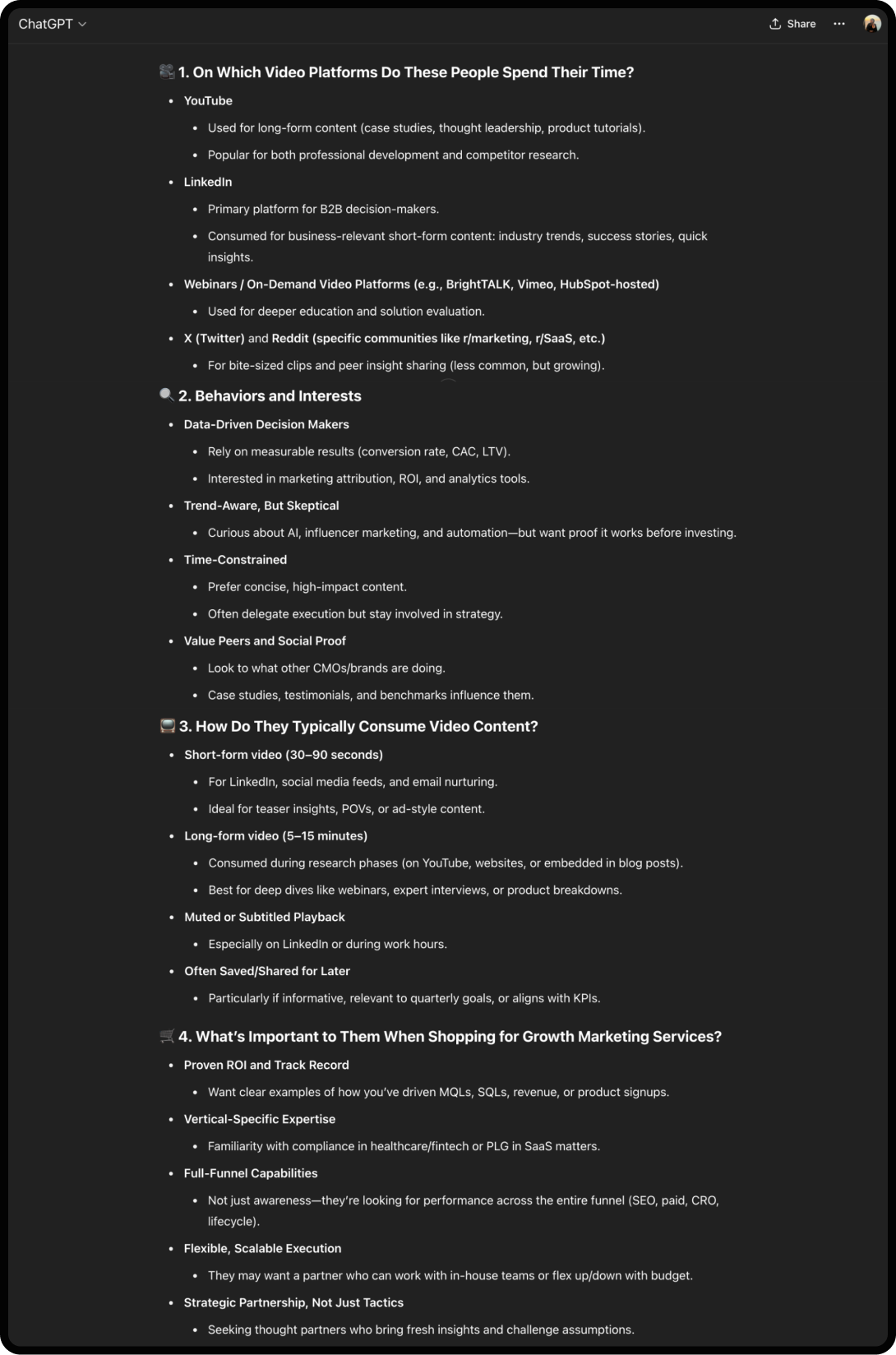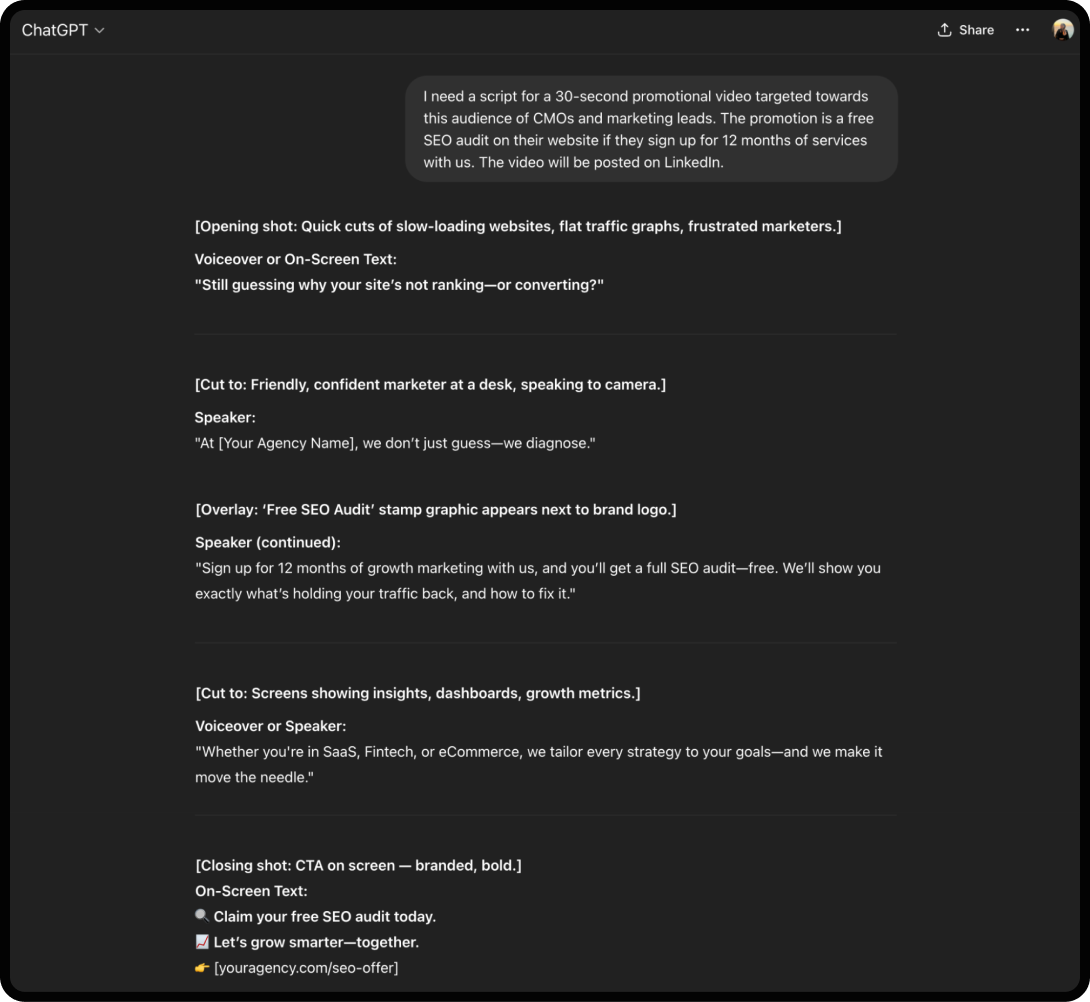At its core, video marketing is about using video content to communicate a key message about your brand or offering to your audience. Whether you’re leveraging video marketing as an acquisition tool for a lead gen campaign or as a community-building play, it’s a vital part of any comprehensive marketing strategy. The power of video marketing lies in its ability to engage audiences through direct, meaningful connection – something other mediums often struggle to achieve.
As is true with most marketing mediums in 2025, video marketing has been irreversibly changed by the introduction and widespread adoption of AI tools like ChatGPT. How-to guides claiming to have “figured it out” and listicles giving marketers “the best ChatGPT prompts for video marketing” run rampant in X threads and Reddit forums.
To some, AI-powered tools like ChatGPT are viewed as a threat to “business as usual” and a “replacement for the human touch.” However, early adopters of AI will urge you to welcome these tools with open arms because they continue to transform the way we collaborate, plan, and execute marketing campaigns, for the better. But how?
How AI Is Changing Video Marketing
Video marketing can be notoriously expensive, time-consuming, and labor-intensive. Many businesses write it off immediately in favor of things like paid search or content writing due to the perceived ROI. The reality is, ChatGPT can help alleviate most of these problems.
One of the key advantages of using ChatGPT in video marketing is its ability to understand the context of a given situation and generate appropriate text, something that typically requires a unique skillset, in-depth industry knowledge, years of specific experience, or all three.
ChatGPT’s extensive and ever-evolving knowledge set can be used to create video scripts that are not only relevant and specific, but also concepted, drafted, refined, and finalized in a short period of time. Additionally, ChatGPT can be used to generate captions and descriptions optimized for specific keywords and phrases, making it incredibly easy to accomplish brand voice, SEO, and content goals alike.
What Are the Types of Video Marketing?
Before diving into all of the incredible ways you can use ChatGPT prompts for video marketing, it’s important to know what type of video you want to create. You wouldn’t go to your creative team and tell them to “design a social post” without any additional context, so why approach ChatGPT that way?
Video marketing comes in many forms, and, as with any marketing strategy, it’s crucial to choose the right platform and video type to align with your end goal.
Before we get into all of the different types of videos you can produce, let’s review the channels and platforms that support videos—and spoiler alert, it’s pretty much all of them:
- Meta (Facebook and Instagram): Videos on Meta are typically 9:16 for Stories and Reels, and 1:1 or 4:5 for Feed posts.
- YouTube: Standard YouTube videos have a 16:9 aspect ratio. That being said, the platform is incredibly responsive, adjusting to fit the size of the viewer’s screen and the aspect ratio of your video accordingly.
- TikTok: The ideal aspect ratio for TikTok is listed as 9:16, however, other aspect ratios are also supported (cut to me watching an entire movie in 15-minute TikTok clips).
- Snapchat: Snapchat’s most widely supported aspect ratio is 9:16. If you’re starting to notice a pattern here, let me know.
- X (formerly Twitter): X may not be an inherently video-based platform, but it supports 16:9, 9:16, and 1:1 aspect ratios.

Okay, now we know what sizes our videos should be depending on the channel we’re using—but what about the content of said videos? After all, just because a video looks nice inside of Instagram or TikTok doesn’t mean it’s relevant, engaging, or worth sticking around for. Here are a few tried-and-true types of video marketing:
Product Explainer Videos
Product explainer videos are designed to educate prospective customers, especially those who may not even be aware of your product, on its value and competitive advantage. While they’re best suited for top-of-funnel awareness, they can also be effective for retargeting mid-funnel audiences.
Product Demo Videos
Product demos are a more in-depth look at your product than a product explainer. Rather than giving a high-level overview of what the offering is and why it’s better than options B and C, product demos often focus on one or two features that really matter to a specific audience. Because product demos are slightly more specialized, they’re great for a warm audience who already knows who you are and what you do.
Storytelling Videos
Storytelling video content is a community play—inserting your offering into a “natural” setting (think a sunscreen brand in your favorite influencer’s beach day video). By positioning your offering as a solution to a problem in context, viewers subconsciously picture themselves in a similar position. This works at any stage of the funnel.
Testimonial & Case Study Videos
Testimonials are already a powerful marketing tool, as people are more likely to trust the recommendations of their peers over the business itself. In a video format, you have the opportunity to take it a step further by including the actual person giving their review, making testimonial video content even more powerful than the written word.
Another version of a testimonial video is a case study video, where the results of someone using your product or service are shown in a quantifiable way. This appeals to middle and bottom of the funnel audiences who are in the Consideration stage and might need that little extra push in the form of real-world results and data.
User-Generated Content (UGC)
User-generated content (UGC) is exactly what it sounds like—video content centered around your offering, created by users. UGC provides a high level of authenticity, and can be combined with other types of video marketing (a product demo showcasing their favorite feature or storytelling with a use case in the real world). Whether it’s a community member or an in-house content creator, UGC is incredibly impactful at every level of the funnel.
Behind the Scenes (BTS) Videos
Behind-the-scenes (BTS) video content peels back the curtain to show the raw, real, and often less refined moments of the production process. This can give viewers an exclusive look at an upcoming product launch, a silly moment in between takes, or a blooper that was simply too good not to share. BTS content fosters connection between your brand and your audience, and is a great middle and bottom-of-funnel marketing play.
Thought Leadership Videos
Thought leadership videos are a great way to demonstrate your knowledge of your offering, audience, and their pain points. It’s particularly useful for companies in spaces like SaaS, Fintech, Healthcare, and other service-based industries (you’re reading a thought leadership article right now, wink wink). This style of content works well for any stage of the funnel, depending on the subject matter of the video itself.
Promotional Videos
Promotional video in video marketing is similar to the promotional content we all know (and some of us love)—dangling an offer as the hook, with the added visual element of a fun motion graphic or a product demonstration. Though this type of video can push conversions in the short term, it’s not recommended as a long-term solution to sustainable growth.
You’re not limited to just these types of videos for your video marketing strategy, though—whether you choose to mix and match, or combine ideas in ways that apply to your offering or audience, part of the beauty of video marketing lies in its fluidity and flexibility. Let’s review how you can best leverage video in your overall marketing strategy.
How Does Video Fit Into My Marketing Strategy?
The first step in building video into your marketing strategy is to solidify your North Star goal—without it, you won’t have a roadmap for determining how video marketing will contribute to your macro strategy.
Are videos something that topically makes sense for your offering? How will you leverage video as a growth lever to achieve the larger goal? Are there specific KPIs (i.e., CTR or engagement time) that you’ll use to gauge performance, or is video a supporting element of a larger strategy component?
This is also a great time to start using ChatGPT—it can be incredibly useful for things like brainstorming or validating modeling and projections. That being said, we don’t recommend relying on it too much at this stage—the bulk of the strategy should come from your growth experts.
Next, you’ll need to identify your target audience—if you’re adding video marketing to an existing campaign, pull from the data you have as a starting point. Add the data you already have, plus the below questions, into ChatGPT and use its response as a starting or validation point:
- On which video platform do these people spend their time?
- What are their behaviors and interests?
- How do they typically consume video content?
- What is important to them when shopping for [your offering]?
- What are their typical pain points?
- How can [your offering] solve their problem?


Now that you have an idea of who you’re talking to, it’s time to move on to another important aspect of the video marketing strategy—deciding what story you want to tell and how you will communicate it. The standard story framework has four core elements. Similarly to how we used ChatGPT for audience insights, we can do the same to flesh out the following elements:
- The Character & Their Goal: The easiest way to ensure that your video marketing strategy speaks to your target audience is to imagine them as a real individual. Take what you know (or feed it back into ChatGPT) and create a persona from the data.
- Their Conflict (Pain Point): Knowing the problem your audience is having puts you in a position to solve it and be their hero. In your video marketing execution, this element will serve as the hook that captures your viewer’s attention.
- Their Quest (Needs): This is where your offering comes in—knowing the viewer and their pain points, how are you going to solve their problem? How will they know they can rely on you to do so? How do they know you’re the best solution to their problem? In the video, the meat of the story will take place here.
- The Resolution: Given that your video marketing strategy aligns with your target audience, this is the “ah-ha moment” when your offering solves the customer’s problem.
Okay, we’ve done all of the prep work—now can we get to the fun part? If you’ve got your strategy laid out and all of the equipment necessary to create your videos, then I’ve got good news—yes, we can.
5 Ways to Use ChatGPT in Video Marketing + Example Prompts
Just like we used ChatGPT to brainstorm and refine our overall video marketing strategy, we can also leverage it for strategy execution. From video scripts, to captions, to descriptions, here are five ways to incorporate ChatGPT into your video workflow, why they work, and some examples:
1. ChatGPT for Video Scripts
ChatGPT can be used to concept, draft, and create high-quality, engaging video scripts instantly. The AI chatbot can incorporate a variety of topics into the script, all while following a list of basic rules and guidelines to ensure brand consistency and audience targeting is maintained.
How This Helps You: Using ChatGPT to write a script for a 10-30 second video takes seconds—this allows your creative team to spend more time creating high-quality video content to go along with the script. Whether the roadblock you’re facing is a tight timeline (gotta get those memes posted, IYKYK) or a lack of creative inspiration, ChatGPT is there to help.
Example Prompt: “I need a script for a 30-second promotional video targeted towards this audience of CMOs and marketing leads. The promotion is a free SEO audit on their website if they sign up for 12 months of services with us. The video will be posted on LinkedIn.”

2. ChatGPT for Captions & Subtitles
Ah, SEO—don’t we all love thinking about it all the time? For video marketing, ChatGPT can be used to simplify your optimization process. Just like it can be used for technical SEO, ChatGPT can also generate captions, subtitles, and hashtags for videos that are optimized for specific keywords and phrases.
How This Helps You: Making sure your video content has subtitles, captions, and tags improves the accessibility and searchability of the video. This makes it easier for users to find and view relevant content. With the growing popularity of using social media as a search engine, this can significantly improve impression and engagement metrics for your video marketing.
On the traditional SEO front, ChatGPT can help you identify keyword clusters—a variety of terms centered around the same topic—that you’ll want to build authority around and create content on.
Example Prompts:
- For hashtags: “Please generate 5-10 potential hashtags for a 30-second video promoting a free SEO audit from a growth marketing agency when clients sign up for 12 months of service. This video will be geared towards CMOs and marketing leads in the SaaS industry and will be posted on LinkedIn.”
- For keyword clusters: “Please generate 5 keyword clusters with 10 keywords in each cluster that are centered around SEO services for SaaS companies.”
3. ChatGPT for Video Descriptions
The video’s description acts as an extension of captions and subtitles, both from an accessibility and SEO standpoint. ChatGPT can summarize the content of your video and optimize it for specific keywords to increase the visibility of your content.
How This Helps You: Using the time saved from copywriting, it’s worthwhile to pursue creative experimentation for different personas. You can do things like use ChatGPT to shift the messaging and tone of your videos for key audiences to validate both the content approach and value propositions.
4. ChatGPT for A/B Testing
Rapid experimentation inherently relies on A/B testing—ChatGPT can serve as an instrumental tool in the workflow. The AI tool can be used to generate multiple versions of video scripts, captions, and descriptions based on various A/B test parameters.
How This Helps You: As your brand ramps up experimentation across platforms, identifying the type of content that resonates best with your target audience is key to improving overall performance. ChatGPT can serve as a brainstorming tool to help you get started and an execution partner to help you create content at scale.
General Tips for Using ChatGPT for Marketing
There are a few tricks I’ve learned that make using ChatGPT even easier, no matter the purpose. I thought I’d leave them with you here:
- When feeding ChatGPT a lot of context, break it out from the actual request. This makes it less likely that the AI will get confused.
- Example: Start a prompt with, “I need you to write me a blog post for a specific audience. I will give you all of the demographic data now, and give you the blog post information once you have processed it and given me the go-ahead. Here is the demographic data: [insert data]. Please give me written confirmation when you are ready for the blog post information.”
- When possible, create specific conversations for similar tasks. This helps ChatGPT stay on task and not get confused with wildly differing requests.
- Example: Have one conversation for video marketing scripts and a separate one for social media captions.
- When referencing an entire document, give the document directly to ChatGPT and ask it to take it into consideration for all following requests. This helps with things like staying on brand in terms of voice and messaging.
- Example: Start a new conversation by attaching a PDF of your brand guidelines and lead with, “I am a marketing lead at [company]. I need your help with writing email copy for a B2B audience. For all following requests, please reference the provided brand guidelines.”
- When creating variations of the same content, always ask for more than you need. This gives you extra options to choose from and can even spark new ideas for the future.
- Example: If you need five varying captions for a social media post, ask ChatGPT for 10-15.
Conclusion
In the era of AI in marketing, ChatGPT continues to prove to be a powerful tool that can be used to enhance video marketing efforts by generating high-quality, unique content that is tailored to the target audience and optimized for specific keywords and phrases.
It allows for the creation of personalized video scripts, captions, and descriptions that address the viewer by name or other demographic information, making the message more personal. Using the above video marketing strategy insights—and the handy tips, tricks, and example prompts provided—there’s virtually no limit to what you can achieve by using AI for video marketing.
And if you’re looking for a team of experts to help you execute a growth-focused video marketing strategy, we’re right here waiting—just drop us a line.





